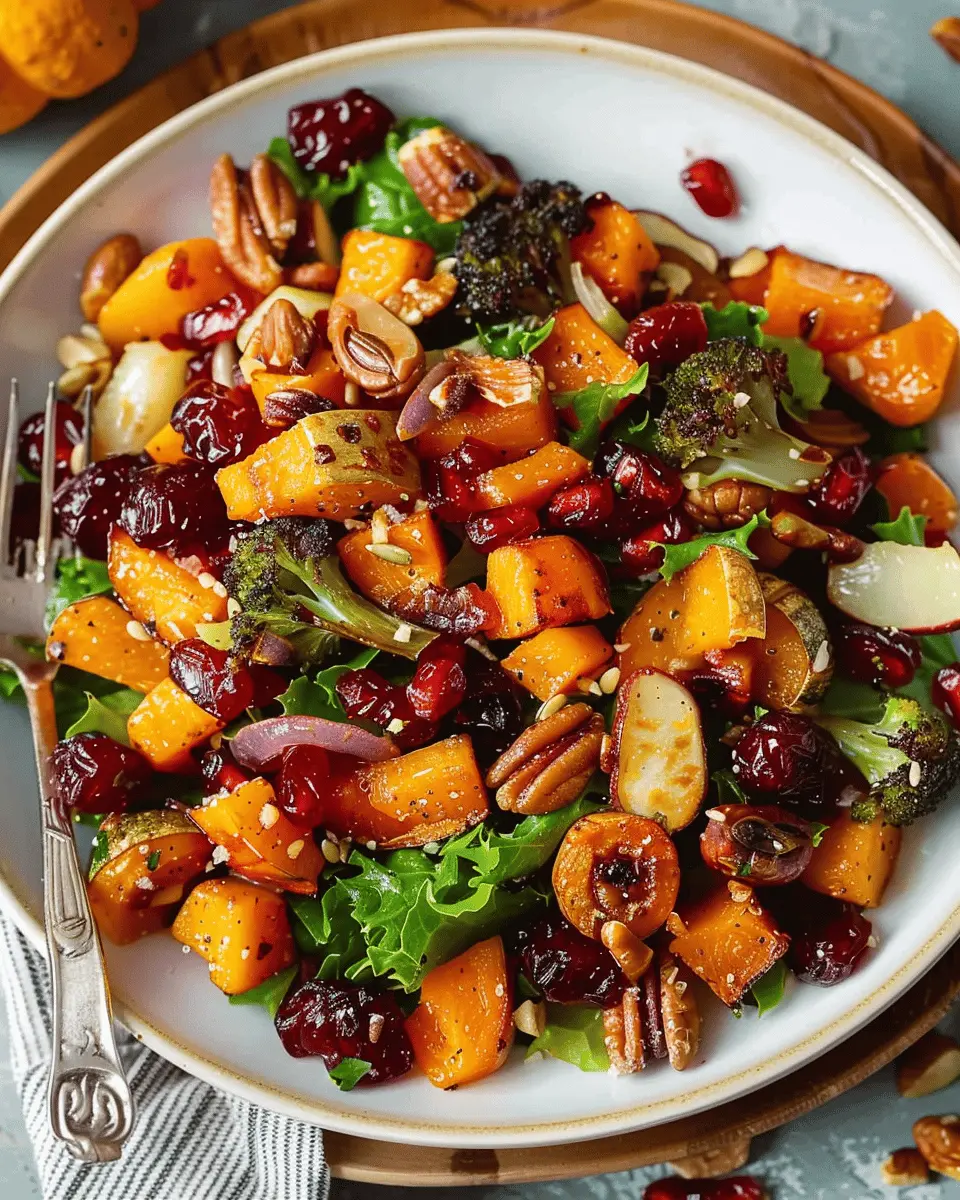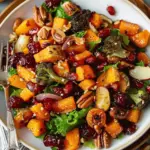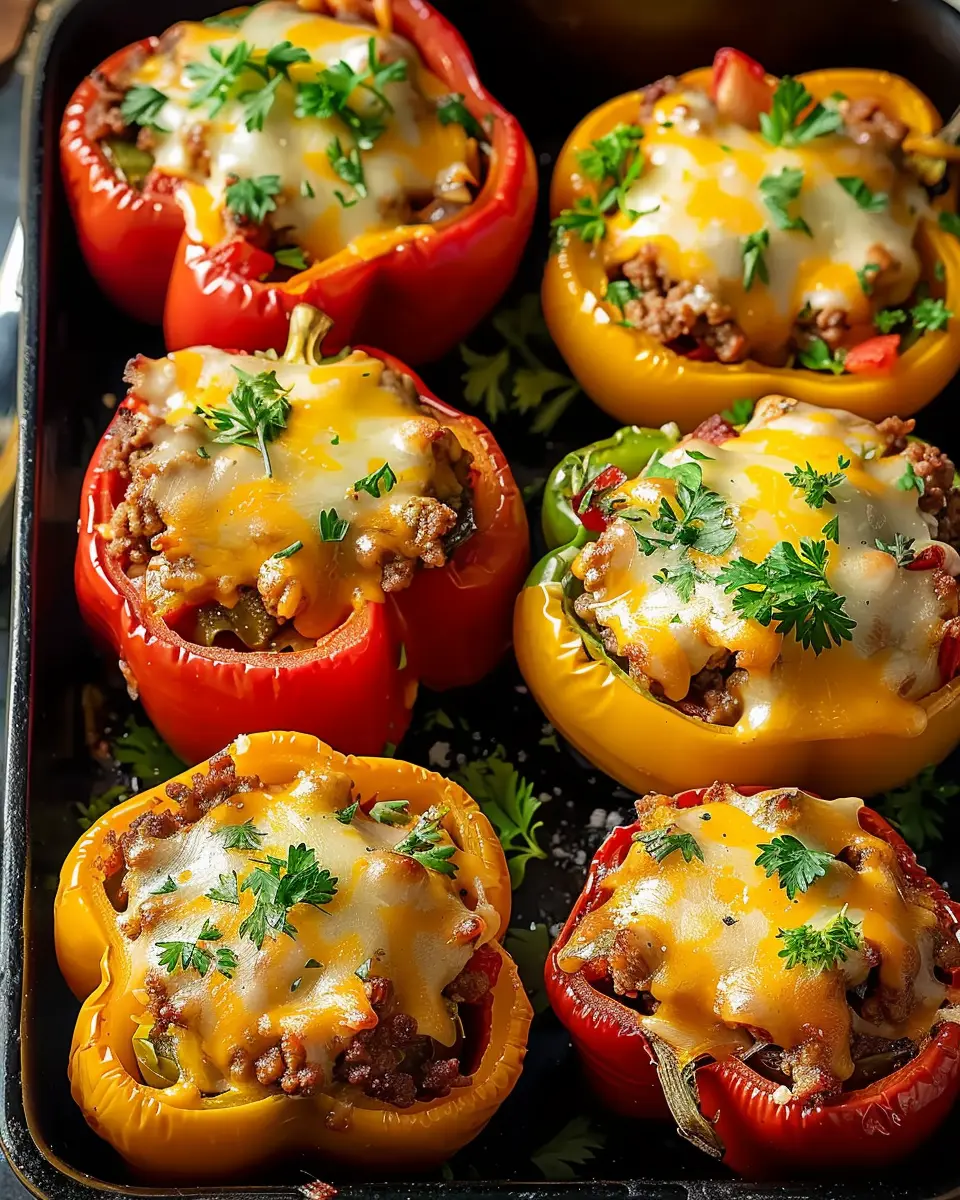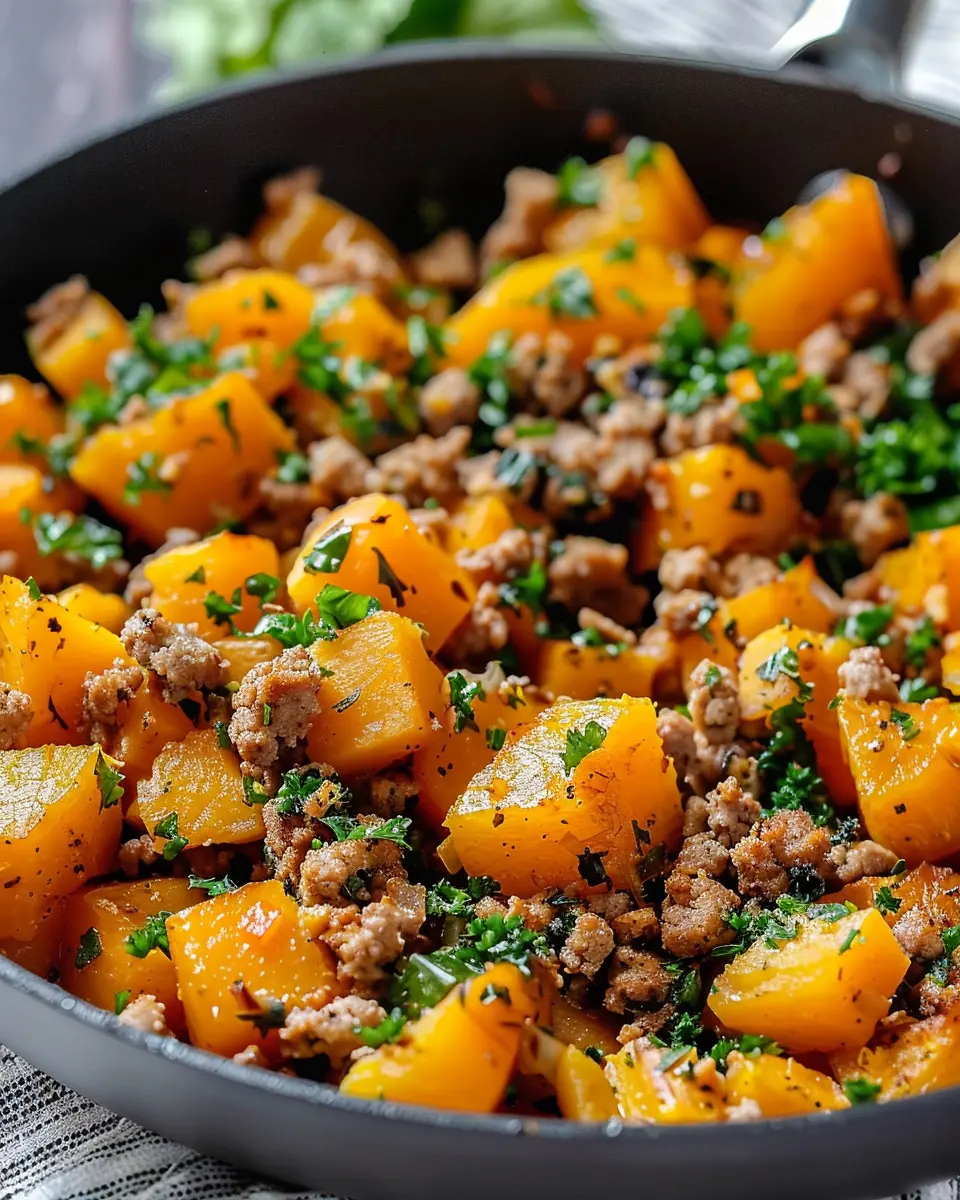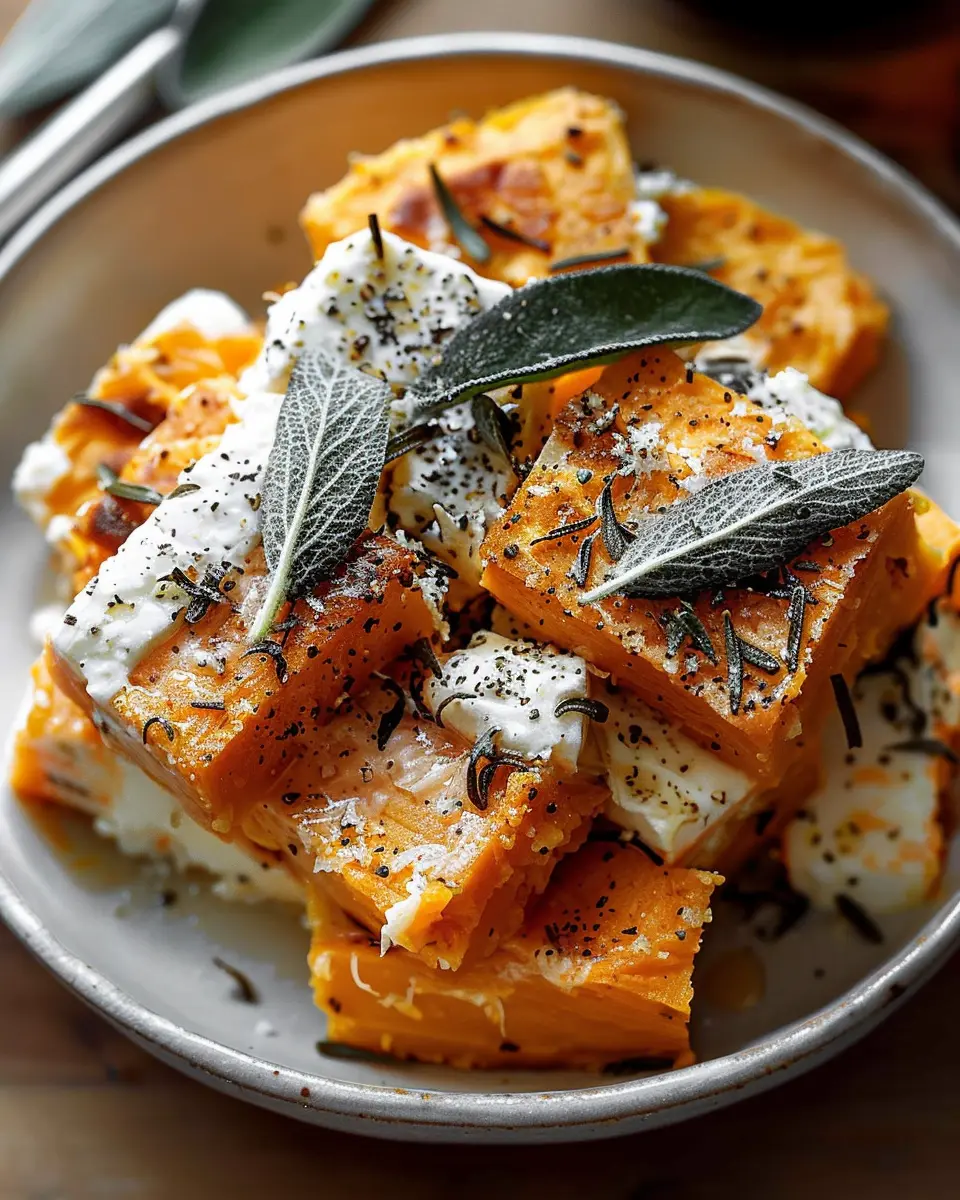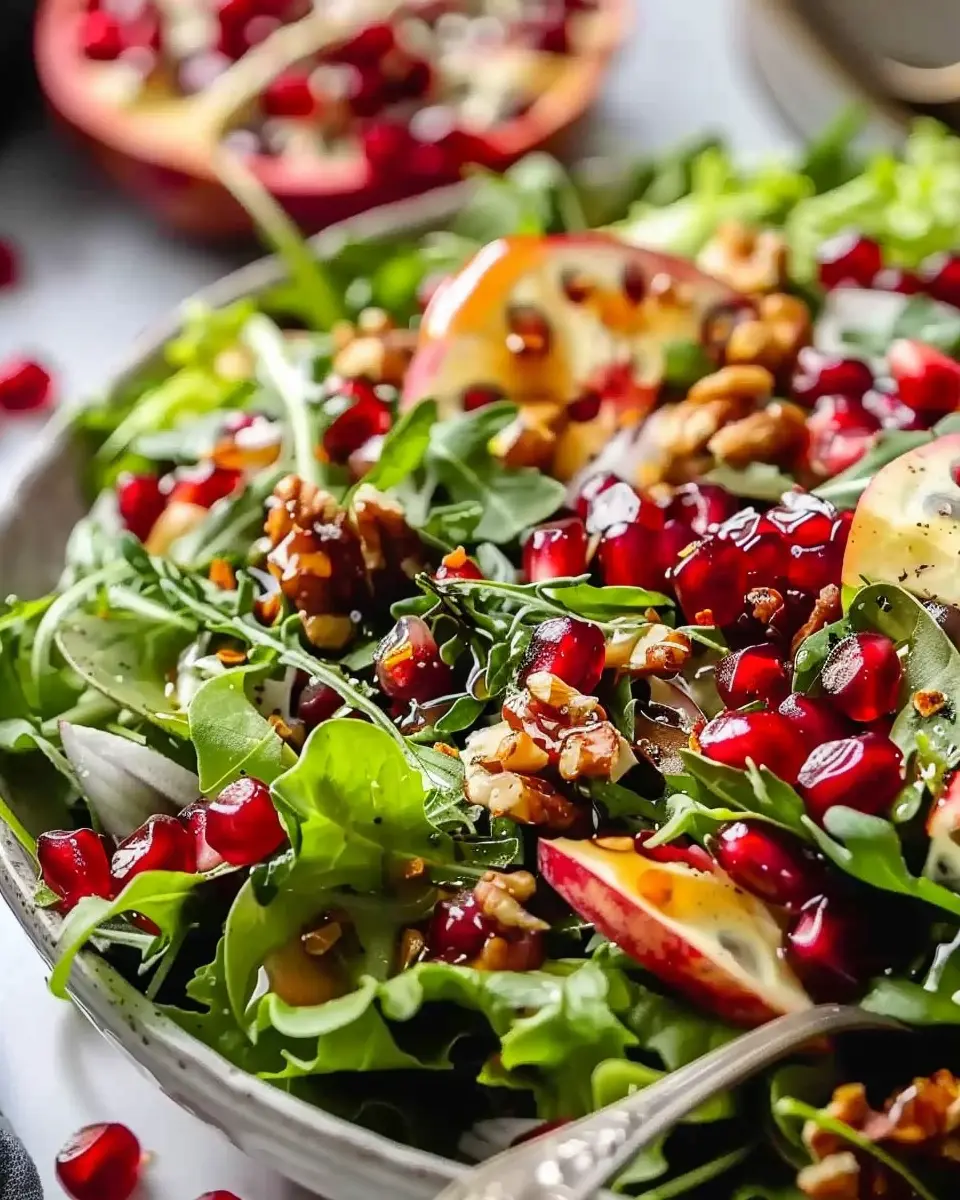Introduction to Winter Vegetable Salad
As the chilly winds of winter sweep in, it’s time to embrace warm, hearty meals while also focusing on nutrition. That’s where a winter vegetable salad shines, especially for young professionals balancing busy schedules and health-conscious choices. Butternut squash, kale, and other seasonal ingredients not only warm you up but also offer vibrant flavors and nutrients that can elevate any lunch or dinner.
Why a Winter Vegetable Salad is Perfect for Young Professionals
For those of you navigating the fast-paced world of work, meal prep can sometimes feel daunting. However, a winter vegetable salad is the perfect solution. It’s quick to assemble, nutritious, and can be prepared in advance—making it a stellar choice for lunch at the office or a healthy dinner after a long day.
One of the key advantages of making a winter vegetable salad is its versatility. You can easily adapt the ingredients based on what’s available. Seasonal vegetables like beets, Brussels sprouts, and sweet potatoes not only provide a burst of color but also pack a nutritional punch. Did you know that consuming a variety of vegetables can help boost your immune system? Incorporating different veggies can help you maximize the health benefits.
In addition to being easy to prepare, preparing a winter vegetable salad is also a budget-friendly option. Many of the ingredients, like squash and kale, are inexpensive and can often be purchased in bulk. If you’re curious about how to save more while eating healthy, check out this guide on budget-friendly cooking tips.
Another perk of a winter veggie salad? It can easily meet your specific dietary preferences. Whether you’re vegetarian, vegan, or just trying to cut back on meat, you can customize your salad with protein options like turkey bacon or chicken ham for added flavor without compromising on health.
Imagine enjoying a comforting bowl of butternut squash mixed with crisp greens and cozy spices after a long day at work. It’s not just food; it’s a moment of warmth, energy, and satisfaction that aligns with your lifestyle. So, are you ready to embrace the wonders of winter salads? Let’s dive into the delicious recipe below!
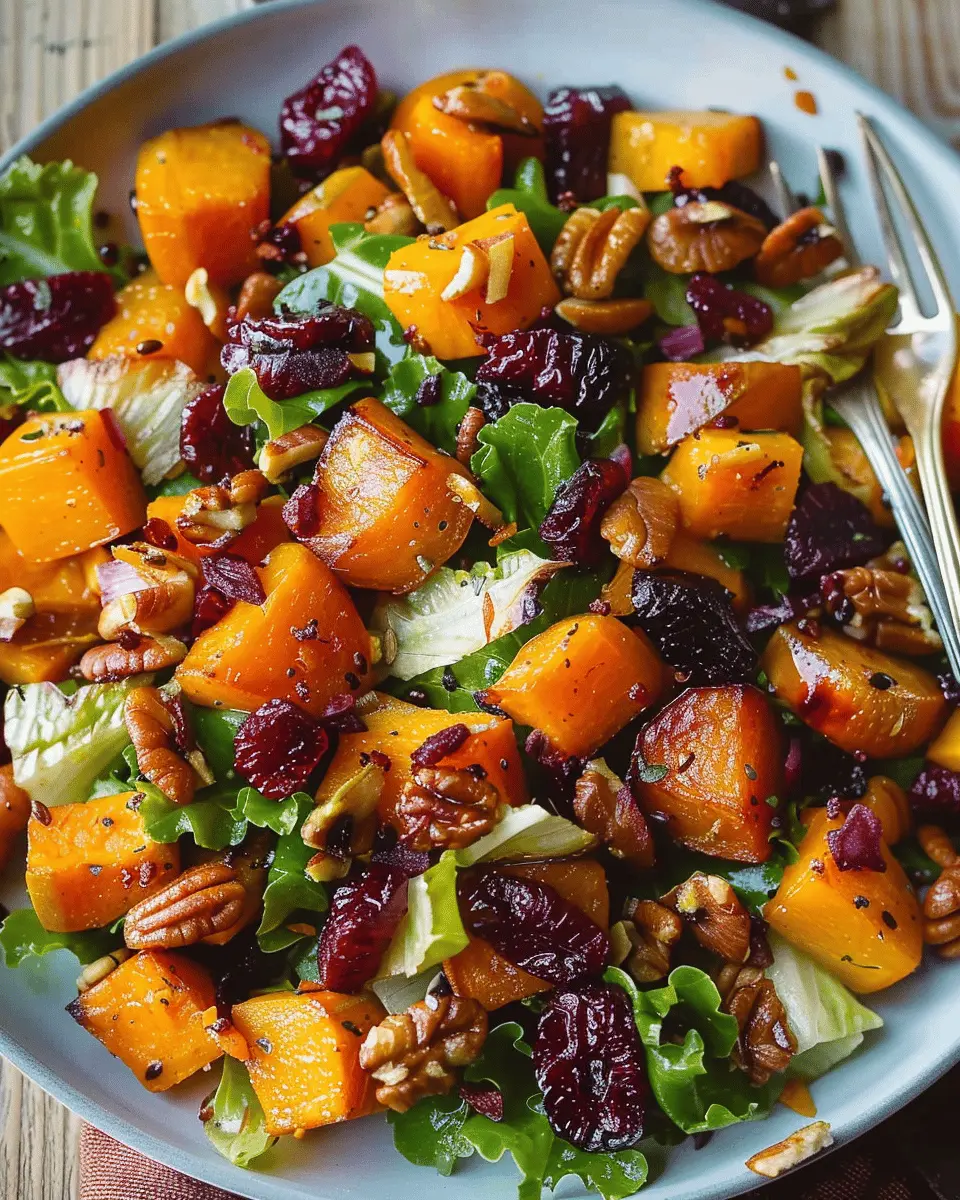
Ingredients for Winter Vegetable Salad
Fresh Vegetables and Their Benefits
A winter vegetable salad is the perfect way to embrace the flavors of the season while packing in essential nutrients. Here’s what you’ll need:
- Butternut Squash: Rich in vitamins A and C, this vibrant squash adds a hint of sweetness and creaminess to your salad.
- Kale: A superstar in the winter vegetable lineup, kale is loaded with antioxidants and helps support your immune system during the colder months.
- Brussels Sprouts: These tiny cabbages are high in fiber and vitamin K, making them a crunchy addition that’s good for digestion.
- Carrots: Full of beta-carotene, carrots lend both color and a satisfying crunch to your dish.
If you want to delve deeper into the benefits of these veggies, check out Healthline’s nutrient breakdown.
Dressing Ingredients
No winter vegetable salad would be complete without a well-balanced dressing. For this recipe, gather:
- Olive Oil: A heart-healthy fat that enhances the salad’s flavors.
- Apple Cider Vinegar: This tangy option balances sweetness with a refreshing zing.
- Maple Syrup: Just a touch adds the perfect amount of sweetness to counter the earthiness of the greens.
This dressing will not only elevate the veggies but also keep your taste buds excited. Are you ready to toss these ingredients together?
Preparing Winter Vegetable Salad
When the chill of winter sets in, hearty salads emerge as a warm, comforting choice. A winter vegetable salad featuring butternut squash, Brussels sprouts, and beets not only celebrates seasonal produce but also imparts warmth and flavor to any meal. Let’s get started on preparing this vibrant, nutritious dish that’s perfect for those frosty evenings.
Prepping the Brussels Sprouts
First up are the Brussels sprouts. These miniature cabbage-like vegetables pack a nutritional punch and a delicious earthy flavor.
- Trim the Ends: Start by removing any discolored or yellowed outer leaves and trimming the stem end of each sprout.
- Halve or Quarter: Depending on your preference, cut the Brussels sprouts in half or quarters to allow for even roasting.
- Wash: Rinse them thoroughly under cold water to remove any dirt or grit.
By prepping them this way, you’ll ensure that the sprouts roast evenly, developing that wonderful caramelized flavor we all love.
Roasting the Butternut Squash
Next, let’s roast some butternut squash, a winter staple known for its versatility and nutty flavor.
- Peel and Dice: After peeling the butternut squash, seed it and cut it into ½-inch cubes.
- Season: Toss the cubes with olive oil, salt, and pepper. Feel free to add a pinch of cinnamon or nutmeg for a cozy flavor profile.
- Roast: Spread the cubes out on a baking sheet and roast them in a preheated oven at 425°F (220°C) for about 25-30 minutes, or until they become tender and slightly caramelized.
Roasting brings out the natural sugars in the squash, creating a delightful balance with the heartiness of the Brussels sprouts.
Cooking the Beets
While the squash is roasting, let’s move on to the beets. These root vegetables not only give your winter vegetable salad a beautiful pop of color but are also rich in vitamins and minerals.
- Peel and Dice: Wash the beets carefully, then peel them and cut into uniform cubes.
- Boil or Roast: You can choose to boil them in salted water for about 30-40 minutes or roast them alongside the squash if you prefer a deeper flavor. If roasting, just toss them in olive oil and pop them in with the squash for about 20-25 minutes.
If you’re new to cooking beets, remember they tend to stain, so wearing gloves can prevent beet-red hands!
Toasting the Pecans
Now for the crunchy element! Toasting the pecans will enhance their flavor and add a lovely crunch to your salad.
- In a Dry Pan: Place the pecans in a dry skillet over medium heat.
- Toast: Stir often for about 5-7 minutes or until they’re fragrant and lightly brown. Be careful not to burn them; pecans can go from perfectly toasted to charred quite quickly.
Adding these toasted pecans not only provides texture but also a delightful richness to your winter vegetable salad.
Making the Balsamic Glaze
A drizzle of balsamic glaze ties this whole dish together beautifully.
- Simmer the Balsamic Vinegar: In a small saucepan, bring 1 cup of balsamic vinegar to a simmer over medium heat.
- Reduce: Allow it to simmer for about 10-15 minutes until it reduces by half and thickens into a syrupy consistency.
- Add Sweetener: If you prefer a sweeter glaze, you can add a tablespoon of honey or maple syrup during the last few minutes of cooking.
This tangy glaze adds a great punch and complements the sweetness of the butternut squash and beets.
Assembling the Salad
Finally, let’s put it all together!
- Create a Base: Start with a bed of mixed greens (like arugula or spinach) on a large platter or in individual bowls.
- Layer In: Add the roasted Brussels sprouts, butternut squash, cooked beets, and toasted pecans over the greens.
- Drizzle with Balsamic Glaze: Finish with a generous drizzle of your homemade balsamic glaze, then toss everything gently to combine.
Your winter vegetable salad is now ready to be savored! Not only is it a feast for the eyes, but it also serves as a wholesome dish packed with nutrients that will energize you through the cold winter months. Enjoy every vibrant bite!
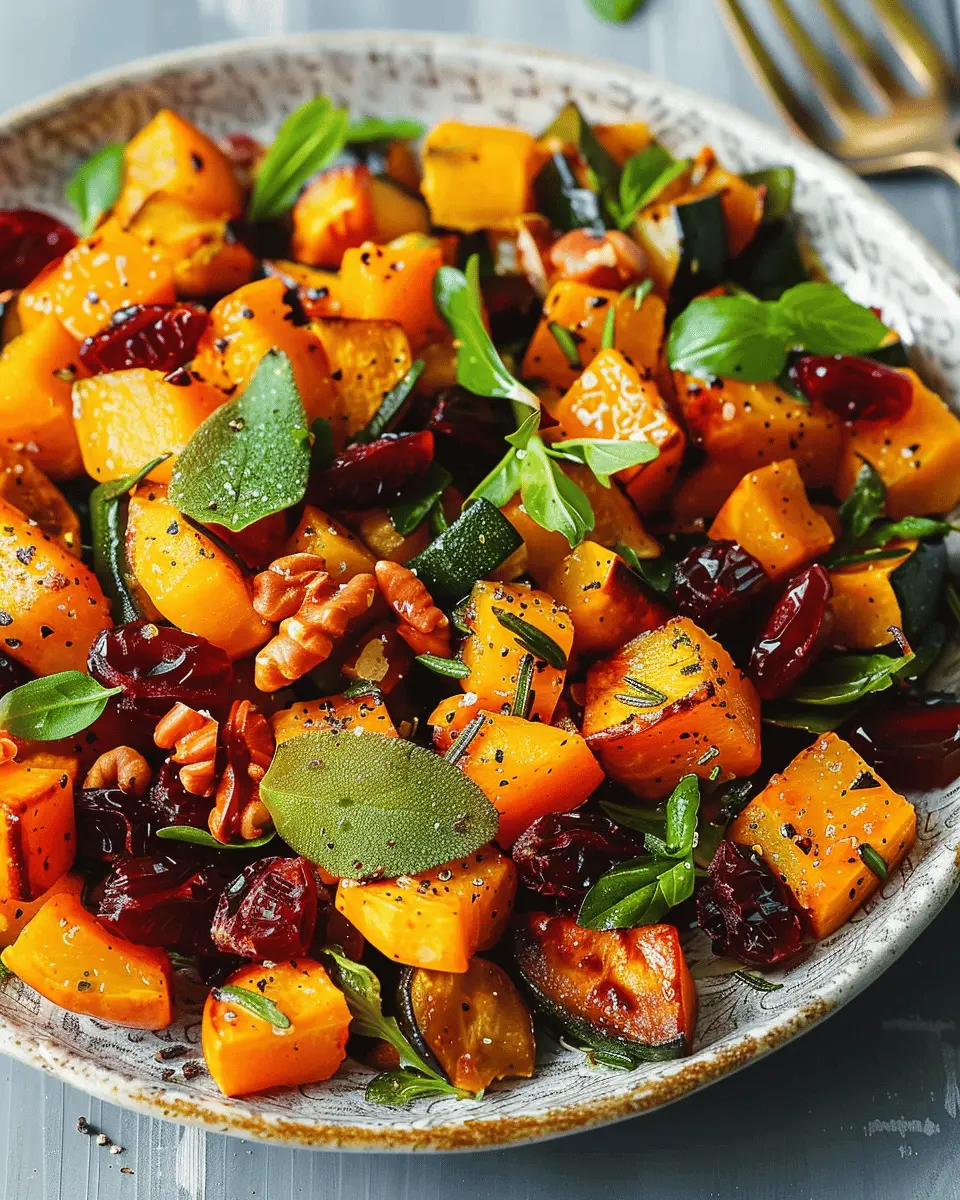
Variations on Winter Vegetable Salad
Adding Protein Options
When it comes to your winter vegetable salad, adding a protein source can transform it from a side dish into a fulfilling main meal. There are plenty of delicious options to consider:
- Chicken Ham: If you’re looking for something savory yet light, diced chicken ham adds a tasty twist.
- Turkey Bacon: For a crunchy texture and smoky flavor, sprinkle in some crispy turkey bacon. It’s lower in fat than traditional bacon but still provides great taste.
- Chickpeas: These are an excellent plant-based option that not only adds protein but also packs a nutritional punch. Plus, they absorb flavors beautifully!
Adding protein not only boosts the salad’s health benefits, but it also keeps you feeling fuller for longer—perfect for those busy days.
Flavor Enhancements
Let’s explore ways to elevate your winter vegetable salad with flavor enhancements that will keep your taste buds dancing. Here are a few ideas:
- Nuts and Seeds: A handful of toasted walnuts or pumpkin seeds adds crunch and healthy fats. Nuts are a great source of protein, making your salad even more satisfying.
- Dressings: Switch up your dressing for a unique twist. A lemon-tahini dressing can offer a zesty flavor while a balsamic vinaigrette provides a sweet and tangy contrast.
- Fresh Herbs: A sprinkle of fresh herbs, like parsley or cilantro, can really brighten up the dish. They not only enhance the flavor but also add a pop of color.
Experimenting with these variations makes each batch of winter vegetable salad a delightful new experience. For more inspiration, check out this resource for creative dressing options or this article for health benefits related to winter veggies. Enjoy the process, and happy salad-making!
Cooking Tips and Notes for Winter Vegetable Salad
Prep Ahead for Busy Weeknights
When life gets hectic, having a delicious winter vegetable salad ready to go can be a lifesaver. To save time, consider prepping your ingredients on the weekend. Roast your butternut squash in advance and store it in the fridge. You can also chop your leafy greens and veggies ahead of time; just keep them in airtight containers. Not only will this make your weeknight dinners smoother, but you’ll also enjoy more fresh, homemade meals!
Storing Leftovers Properly
If you find yourself with leftover salad, no worries! To keep your winter vegetable salad fresh, store it in a container with a tight seal. Aim to keep the dressing separate until you’re ready to eat, as this will prevent sogginess. Leftovers can last up to three days in the fridge, making it a perfect grab-and-go lunch option. For tips on best practices for food storage, check out the USDA’s Food Safety Resource Center for comprehensive guides.
By following these simple steps, you’ll be well on your way to making the most of your winter vegetable salad—delicious, convenient, and stress-free!
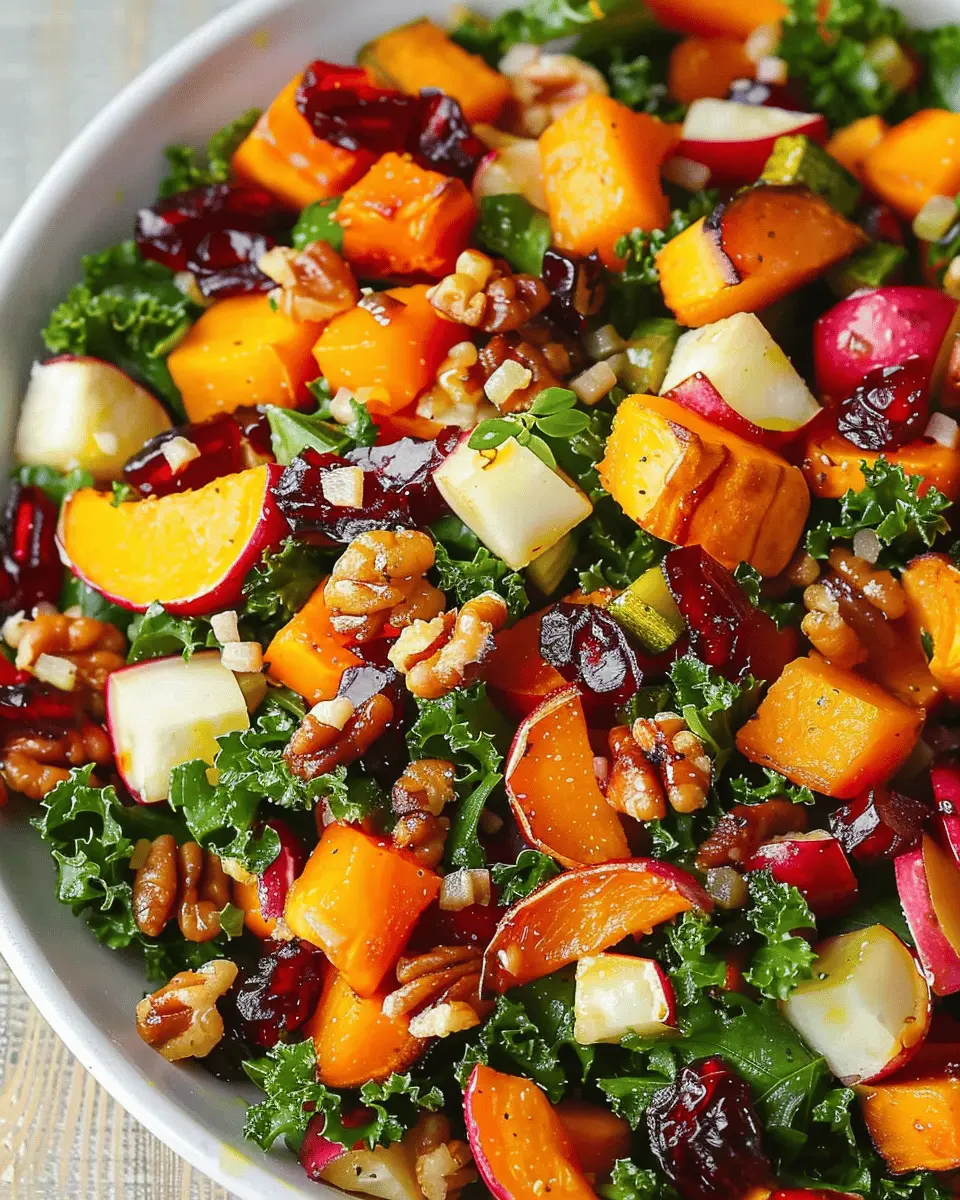
Serving Suggestions for Winter Vegetable Salad
Best Pairings for a Complete Meal
When enjoying your winter vegetable salad with butternut squash, consider complementing it with protein for a well-rounded meal. Grilled chicken or turkey bacon can add a savory touch, while chickpeas keep it plant-based and nutritious. If you’re a cheese lover, crumbled feta or goat cheese brings a delightful creaminess that contrasts beautifully with the crunchy veggies. For a comforting side, think about serving this salad alongside hearty whole-grain bread or a bowl of warm lentil soup.
Additionally, a refreshing beverage like sparkling water infused with lemon or a soothing herbal tea can enhance your dining experience. Looking for more ideas? Check out some of our favorite pairings at Serious Eats for inspiration!
Stunning Presentation Ideas
Presentation is key when it comes to impressing your guests. Serve your winter vegetable salad in a large wooden salad bowl to give it a rustic feel. Consider layering the ingredients in a clear glass dish for a vibrant visual treat. Garnish with toasted seeds or nuts for that extra crunch and vibrancy.
For a festive touch, sprinkle pomegranate seeds on top—they not only pop with color but also add a burst of juicy sweetness. Using a mix of serving platters can elevate your meal, creating a buffet-like vibe that encourages sharing and enjoyment. Your guests will be talking about this salad long after the meal is over!
Time Breakdown for Winter Vegetable Salad
Preparation Time
To whip up this delicious winter vegetable salad, you’ll need about 15 minutes. During this time, you can wash, peel, and chop your fresh veggies, such as the vibrant butternut squash and any additional greens you’re including. Pro tip: prepping ingredients while enjoying your favorite playlist can make the process so much more enjoyable!
Roasting Time
The next step is the roasting, which typically takes 25-30 minutes. This step is crucial for enhancing the flavors of our winter salad. Just pop the butternut squash in the oven, and let the sweet aromas fill your kitchen—it’s the perfect opportunity to unwind while waiting.
Total Time
Altogether, you’re looking at a total time of about 45 minutes to enjoy a hearty and vibrant winter vegetable salad. With such a short prep and cooking time, you can easily fit this into a busy weeknight routine, all while maximizing flavor and nutrition. Why not take a look at Sustainable Food Center for some tips on selecting the best seasonal veggies?
Nutritional Information for Winter Vegetable Salad
Calories and Macronutrients
A serving of this delightful winter vegetable salad is packed with around 220 calories, making it a perfect light meal or a side dish. It beautifully balances macronutrients: roughly 40 grams of carbohydrates, 6 grams of protein, and 8 grams of healthy fats. This nutrient profile supports an active lifestyle while keeping you satisfied.
Health Benefits of Main Ingredients
Let’s explore why this salad is not just tasty but also a health powerhouse:
- Butternut Squash: Rich in vitamins A and C, it boosts your immune system and promotes healthy skin.
- Kale: A fantastic source of iron and antioxidants, it helps improve heart health and reduce inflammation.
- Turkey Bacon: Offering lean protein, it’s a satisfying choice that keeps the calorie count low.
- Chickpeas: Packed with fiber and protein, they support digestion and promote satiety.
For an in-depth look at nutritional benefits, consider checking out resources like the Harvard T.H. Chan School of Public Health. Enjoy this winter delight knowing that each bite nourishes your body!
FAQs about Winter Vegetable Salad
Can I use different vegetables?
Absolutely! One of the great things about a winter vegetable salad is its flexibility. While butternut squash adds a delightful sweetness and texture, you can easily swap it out for other hearty winter veggies. Consider using roasted Brussels sprouts, earthy beets, or even sweet potatoes. The key is to incorporate those bold, seasonal flavors. If you want some crispness, add raw veggies like carrots or radishes for a refreshing crunch. Just remember, adjust your roasting times in accordance with the vegetables you choose.
How do I make it vegan?
Making this winter vegetable salad vegan is a cinch! Simply omit any animal products, such as cheese or turkey bacon (you can replace it with a vegan alternative like coconut bacon or marinated tofu for added protein). For the dressing, use a mix of olive oil, lemon juice, and Dijon mustard—just skip any honey and opt for maple syrup instead if you desire a touch of sweetness. This way, you maintain flavor richness while keeping it entirely plant-based!
What can I serve with this salad?
This winter vegetable salad is incredibly versatile and pairs well with many dishes. Think of it as a perfect side to roasted chicken ham or even a cozy bowl of vegetable soup. It can also be a hearty standalone meal alongside some quinoa or a warm grain bowl. If you’re hosting, consider serving it with crusty bread or a savory tart to impress your guests. The vibrant flavors really shine, no matter how you serve it! For more pairing ideas, check out resources from The Kitchn or BBC Good Food.
Conclusion on Winter Vegetable Salad
In a fast-paced world, embracing homemade meals like your winter vegetable salad can be a game-changer. Not only does it boost your health, but it also allows for creativity in the kitchen. Using ingredients such as roasted butternut squash and turkey bacon transforms your winter vegetable salad into a cozy delight. Preparing your meals at home fosters a deeper relationship with your food and ensures you know exactly what goes into every bite. So, next time you’re tempted by takeout, remember the joy of crafting a vibrant winter vegetable salad that warms both your body and soul. Ready to dive in?
For more inspiration, check out delicious options at EatingWell and useful kitchen tips from Bon Appétit.
PrintWinter Vegetable Salad: Best Recipe with Butternut Squash and Turkey Bacon
This winter vegetable salad made with butternut squash and turkey bacon is a delightful and healthy option for the colder months.
- Prep Time: 15 minutes
- Cook Time: 25 minutes
- Total Time: 40 minutes
- Yield: 4 servings 1x
- Category: Salad
- Method: Roasting
- Cuisine: American
- Diet: Gluten-free
Ingredients
- 2 cups butternut squash, diced
- 4 slices turkey bacon, cooked and crumbled
- 1 cup spinach, chopped
- 1 cup kale, chopped
- 1/4 cup red onion, thinly sliced
- 1/2 cup cranberries, dried
- 1/4 cup feta cheese, crumbled
- 1/4 cup walnuts, chopped
- 3 tablespoons olive oil
- 2 tablespoons apple cider vinegar
- 1 teaspoon Dijon mustard
- Salt and pepper to taste
Instructions
- Preheat the oven to 400°F (200°C).
- Toss the diced butternut squash in olive oil, salt, and pepper, and roast in the oven for about 25 minutes or until tender.
- In a large bowl, combine spinach, kale, red onion, cranberries, feta cheese, and walnuts.
- Add the roasted butternut squash and crumbled turkey bacon to the salad.
- In a small bowl, whisk together olive oil, apple cider vinegar, Dijon mustard, salt, and pepper.
- Pour the dressing over the salad and toss to combine.
Notes
- Feel free to add your favorite winter vegetables.
- This salad can be served warm or cold.
Nutrition
- Serving Size: 1 serving
- Calories: 250
- Sugar: 8g
- Sodium: 250mg
- Fat: 15g
- Saturated Fat: 3g
- Unsaturated Fat: 10g
- Trans Fat: 0g
- Carbohydrates: 22g
- Fiber: 5g
- Protein: 8g
- Cholesterol: 15mg
Keywords: winter salad, butternut squash, turkey bacon, healthy salad

